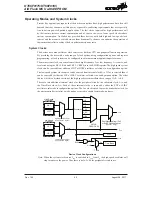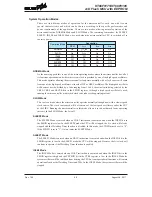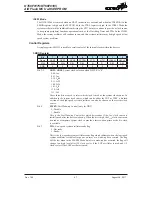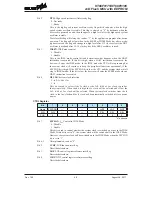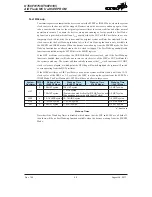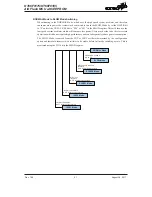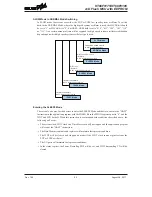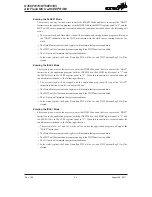
Rev. 1.50
54
����st ��� �01�
Rev. 1.50
55
����st ��� �01�
HT66F0175/HT66F0185
A/D Flash MCU with EEPROM
HT66F0175/HT66F0185
A/D Flash MCU with EEPROM
Programming Considerations
The high speed and low speed oscillators both use the same SST counter. For example, if the system
is woken up from the SLEEP0 Mode and both the HIRC and LXT oscillators need to start-up from
an off state. The LXT oscillator uses the SST counter after the HIRC oscillator has finished its SST
period.
• If the devices are woken up from the SLEEP0 Mode to the NORMAL Mode, the high speed
system oscillator needs an SST period. The devices will execute first instruction after HTO is
“1”. At this time, the LXT oscillator may not be stability if f
SUB
is from LXT oscillator. The
same situation occurs in the power-on state. The LXT oscillator is not ready yet when the first
instruction is executed.
• If the devices are woken up from the SLEEP1 Mode to NORMAL Mode, and the system clock
source is from the HXT oscillator and FSTEN is “1”, the system clock can be switched to the
LIRC oscillator after wake up.
• There are peripheral functions, such as WDT and TMs, for which the f
SYS
is used. If the system
clock source is switched from f
H
to f
SUB
, the clock source to the peripheral functions mentioned
above will change accordingly.
• The on/off condition of f
SUB
and f
S
depends upon whether the WDT is enabled or disabled as the
WDT clock source is selected from f
SUB
.
Watchdog Timer
The Watchdog Timer is provided to prevent program malfunctions or sequences from jumping to
unknown locations, due to certain uncontrollable external events such as electrical noise.
Watchdog Timer Clock Source
The Watchdog Timer clock source is provided by the internal clock, f
SUB
, which is in turn supplied
by the LIRC or LXT oscillator. The LXT oscillator is supplied by an external 32.768 kHz crystal.
The LIRC internal oscillator has an approximate frequency of 32 kHz at a supply voltage of
5V. However, it should be noted that this specified internal clock frequency can vary with V
DD
,
temperature and process variations. The Watchdog Timer source clock is then subdivided by a ratio
of 2
8
to 2
18
to give longer timeouts, the actual value being chosen using the WS2~WS0 bits in the
WDTC register.
Watchdog Timer Control Register
A single register, WDTC, controls the required timeout period as well as the enable/disable
operation. This register controls the overall operation of the Watchdog Timer.





